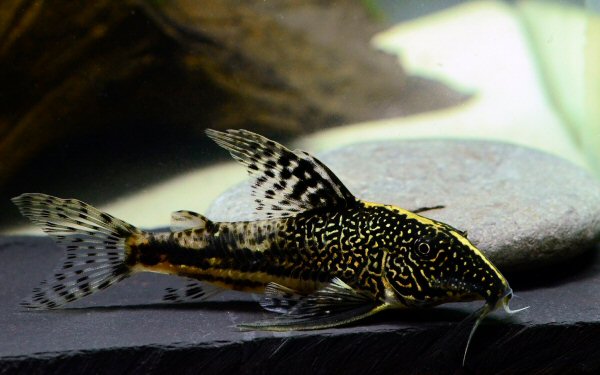SCOTCAT.COM
your internet guide to all things catfish
| Corydoras Cousins! |
| by Rob McLure |
|
 Scleromystax barbatus
When I was a kid first getting into aquariums, my parents bought me a very simple “Aquarium Fish” book, it had basic set up instructions, perfect for the 1970’s and early 80’s with incandescent lights, undergravel filters, and little decorative signs for your tank that said “No Fishing”. It also had colored drawings and short descriptions of many of the available aquarium fish at the time. Near the back of the book was the Catfish section, and on one of the last pages was an amazing drawing of a plated catfish with brilliant white, black and gold coloration and long flowing fins. “I have to have this fish!” I remember thinking. But unfortunately for me, that would not happen for around another 30 years!. The drawing in my old book was labeled Corydoras barbatus “The bearded catfish”, not by the name we know it today and I hope by giving you a little history I can explain why. Believe it or not, Scleromystax barbatus was one of the first Corydoras-like fish ever known to humankind. It was discovered near the city of Rio de Janeiro around a city named Maje, in Brazil. Quoy & Gaimard were the two French naturalists who described it in 1824, to give you an idea of how long ago that was, these two were sent out on a mission to discover new animals for French science by Napoleon! In their travels they went to the home of another naturalist, the Russian Consulate to the then Portuguese colony of Brazil – Baron Langsdorff. The Baron had collected examples of animals near his farm in Brazil and among his collection was Scleromystax barbatus. When Quoy & Gaimard described barbatus, there was no genus called Scleromystax at the time, and Corydoras itself had only been recently created. They gave it a very generic catfish genus Callicthys and named it Callicthys barbatus. It wasn’t until 1864 that the German born British Zoologist decided that this fish was definitely not an ordinary “Callichthys” catfish and created the genus Scleromystax, placing barbatus in the genus as it’s only member. Shortly thereafter, the entire genus Scleromystax was erased by another scientist who placed barbatus back into Corydoras, where it remained until it was resurrected in 2003 by the current curator of fishes at the University of Rio De Janeiro, Marcelo Britto. All these name changes, and I bet if you asked the fish, they would not even care what they were called! Today there are 8 described species of Scleromystax and a number of undescribed types that have occasionally made their way into the hobby. These are some of my favorite fish, and range in breeding difficulty from fairly simple to nearly impossible! An aquarist in Brazil I have spoken to has let me know that he has collected Scleromystax barbatus larger than 5 inches, which would make it the largest of all the Corydoras related fish (Corydoradinae). I have had a few that were pushing 4 inches, but never anything that large yet. Well as always, I hoped I have at least sparked your interest, and look forward to sharing more with you in the near future! This article was first pulished for the Milwaukee Aquarium Society August 2020
|
| Photo Credit |
Author |
If you would like to contribute an article, please e-mail me. You will of course be credited for your work.
If you would like to donate any denomination of money to the site just click the above link button. All proceeds will go to running the site and hopefully to keep it going for a few years yet.
Print or e-mail this factsheet below

